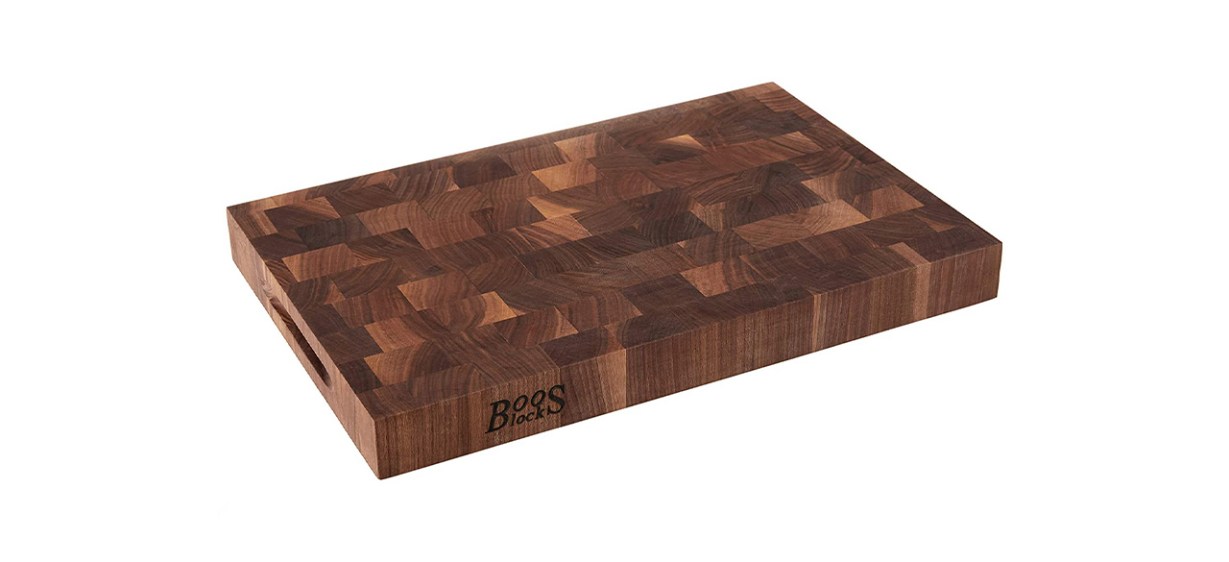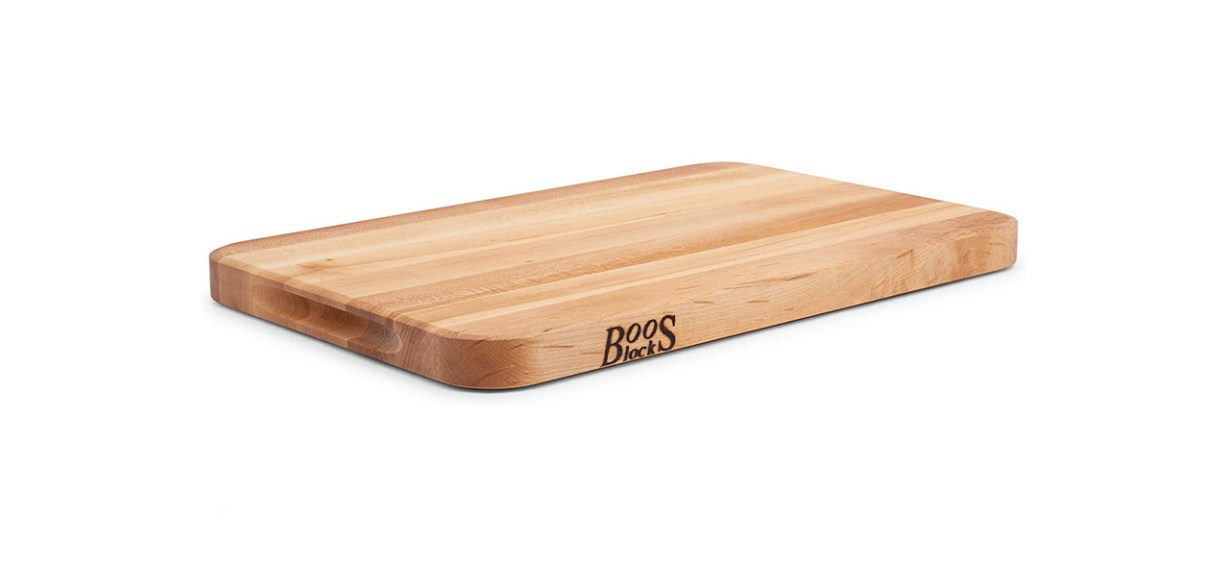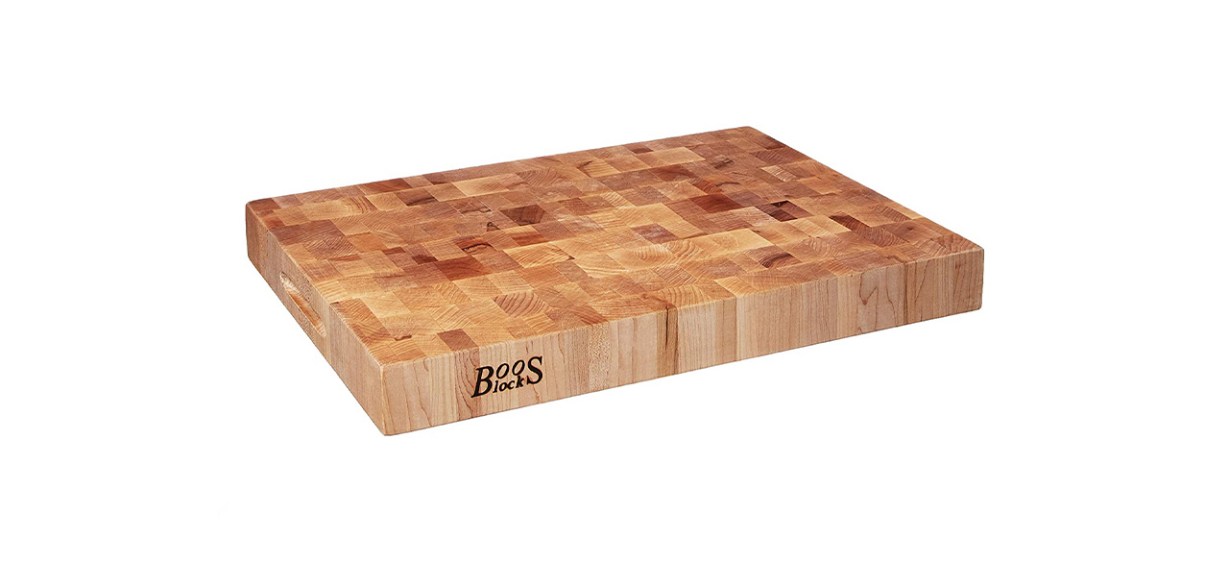Which John Boos cutting board is best?
Buying and maintaining the right cutting board is crucial to three important parts of cooking. First and foremost, keeping a clean, high-quality cutting board encourages food-safe practices. Secondly, a stable, reliable cutting surface promotes good knife technique. Finally, the right material ensures the cutting board won’t damage your blades’ finely sharpened edges.
John Boos cutting boards, also known as Boos blocks, are among the best wooden cutting boards. The top premium option for most people is the John Boos Walnut End Grain, which will last a lifetime while treating your knives well and giving you plenty of space for cutting.
What to know before you buy a John Boos cutting board
They’re food safe
Despite popular belief, wooden cutting boards are as safe for cutting all kinds of food as those made from any other material. This includes meat. It’s a common misconception that wood is unsafe. It stems mostly from the belief that wooden cutting boards can trap bacteria and moisture, causing the bacteria to spread and contaminate food.
The reality is actually closer to the opposite. The matrix of fibers in a wooden cutting board is extremely dense, and doesn’t let bacteria multiply much at all. Instead, quality wood dries out or desiccates bacteria. This is in contrast to plastic, which is prone to trapping bits of food and bacteria, especially after it’s been used for many months.
They repair themselves
As a fibrous, porous material, wood tends to flex and expand ever so slightly when it gets wet. One of the effects of this is that deep grooves and gouges often disappear from wooden cutting boards over time. Once again, plastic comes up short here, because once a plastic cutting board is damaged, there’s no fixing it.
They’re good long-term investments
John Boos cutting boards are not cheap, because they’re made with premium materials and design. It’s rare that a Boos block experiences manufacturer defects, so you can rest assured that yours will last for years, as long as you treat it right.
What to look for in a quality John Boos cutting board
End grain vs. edge grain
Edge grain cutting boards are made from slats of wood laying on their sides, while end grain boards use pieces of wood standing on their ends. The result is that your knife will safely penetrate an end grain cutting board slightly more on a microscopic level. That’s a good thing. End grain cutting boards are notably softer and, therefore, much less damaging to knife edges.
That’s not to say there aren’t good edge grain boards — there are plenty. But if you’ve spent money and time buying and maintaining high-end knives (especially Japanese-style knives, which are often expensive and tough to sharpen), an end grain board will protect your investment better.
Size
Your cutting board should be about as big as will reasonably fit on your countertop. It should, at the very least, be taller than your biggest chef’s knife is long. Bigger cutting boards give you more space to work, which isn’t just convenient. It’s also safer, as it’s easier to navigate piles of prepped food on a large cutting surface. Finally, it encourages good knife technique, letting you cut at just the right angle.
Type of wood
There are many great woods for making cutting boards. Maple is the most popular low-cost variety, but acacia is nearly on the same level because it’s softer, arguably more attractive and costs just about as little. Premium boards are often made from teak or walnut, which can look fantastic when properly finished.
Woods to avoid include incredibly hard types such as oak, which can wear down knives overly quickly.
How much you can expect to spend on a John Boos cutting board
The simplest ones cost only around $40, while the largest, made with the most premium wood, can get as high as $400.
John Boos cutting board FAQ
Are cutting board countertops a good idea?
A. They certainly look nice at first, but the whole point of cutting board countertops is to use them. Ultimately, most homeowners end up disliking the unclean look of scratched wooden countertops. Since it’s inevitable that your cutting board will get scratched over time, it’s not the best idea to install permanent wooden countertops and use knives directly on them. Plus, they’re even more expensive than traditional Boos boards.
Do bamboo cutting boards work well?
A. They’re durable and relatively hygienic, but bamboo is significantly harder than other woods and it’s not good for your knives. Whether you’re using soft Western-style alloys or hard Japanese-style blades, bamboo cutting boards make them dull more quickly, and nobody wants that. Plus, while bamboo supposedly has chemical antibacterial properties, it’s not actually superior to normal wood in terms of food safety. Most people should avoid bamboo cutting boards.
How do I maintain a wooden cutting board?
A. When you get your new cutting board, the first step is to clean it thoroughly to remove any residual chemicals or sawdust from the factory. Then, apply a layer of food-grade mineral oil. The oil keeps the wood flexible and water-resistant, which helps to maintain knife edges, prevent bacteria contamination and heal the wood when it eventually gets scratched and gouged.
Like any cooking surface or tool, clean your cutting board thoroughly after every use using warm water and dish detergent.
What’s the best John Boos cutting board to buy?
Top John Boos cutting board
What you need to know: It’s one of the most premium options available, and perfect for high-end knives.
What you’ll love: The end grain walnut construction doesn’t just perform remarkably well, it’s also extremely attractive. If money’s not an issue and you want something bigger and even more effective, consider this larger version.
What you should consider: While it is quite expensive, it should last a lifetime with proper care.
Where to buy: Sold by Amazon and Sur La Table
Top John Boos cutting board for the money
What you need to know: It’s part of the most affordable Boos series, yet still built and finished with the same care as its high-end relatives.
What you’ll love: It’s as durable and affordable as a Boos block gets. Plus, it’s not as heavy or thick as some of the most premium offerings.
What you should consider: Since it’s an edge grain board, it’s not ideal for super expensive knives, as it will wear down the edge slightly faster than end grain boards do.
Where to buy: Sold by Amazon and Sur la Table
Worth checking out
What you need to know: It offers end grain construction and long-lasting durability, yet it’s not the most expensive Boos board out there.
What you’ll love: It looks great, it’s not terribly heavy, and it’s suitable for the most high-end knives imaginable.
What you should consider: Like other end grain Boos blocks, it’s not cheap.
Where to buy: Sold by Amazon and Sur la Table
Want to shop the best products at the best prices? Check out Daily Deals from BestReviews.
Sign up here to receive the BestReviews weekly newsletter for useful advice on new products and noteworthy deals.
Chris Thomas writes for BestReviews. BestReviews has helped millions of consumers simplify their purchasing decisions, saving them time and money.
Copyright 2022 BestReviews, a Nexstar company. All rights reserved.















